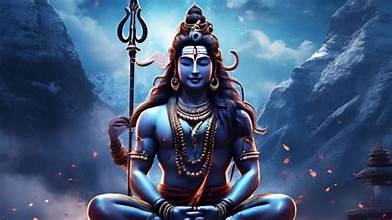Why Meditation Is Central to Shiva’s Spiritual Teachings!

In the vast tapestry of Hindu spirituality, Lord Shiva stands as one of the most enigmatic and profound deities, a symbol of stillness and destruction, of transcendence and transformation. Among his many divine attributes, it is his association with meditation that truly defines his spiritual essence. Often depicted seated in deep contemplation atop Mount Kailash, eyes half-closed, body motionless, Shiva embodies the eternal meditator, the Adiyogi, the first yogi. Meditation, within the context of Shiva’s teachings, is not merely a practice; it is a pathway to ultimate liberation (moksha). To understand why meditation is central to Shiva’s spiritual teachings, one must delve into his symbolism, philosophy, and the timeless message he offers humanity.
1. Shiva as the Adiyogi: The Source of Meditation
Shiva is revered as the Adiyogi, the originator of yoga and meditation. According to ancient yogic lore, thousands of years ago, Shiva entered a state of deep meditation at the summit of the Himalayas. His presence was so still and radiant that it attracted seekers from across realms. When seven of these seekers, later known as the Saptarishis (Seven Sages), approached him with humility and perseverance, Shiva finally opened his eyes and transmitted the knowledge of yoga and meditation to them.
This transmission was not through words alone but through direct experience, dhyana, the meditative absorption that transcends intellect. The Saptarishis, in turn, carried this sacred knowledge across the world, giving rise to diverse yogic traditions. Thus, meditation, as taught by Shiva, became the root of all paths of self-realization.
For Shiva, meditation is not about escaping the world but about mastering one’s inner energies and transcending the limits of the mind. It is through stillness that one experiences the boundless consciousness, Shiva Tattva, the essence of existence itself.
2. The Symbolism of Shiva in Meditation
Shiva’s iconic meditative image conveys deep spiritual symbolism. His eyes are half-closed, representing balance between inner and outer worlds — awareness of both material reality and spiritual truth. The crescent moon on his matted hair symbolizes time under control, while the river Ganga flowing from his locks signifies the uninterrupted stream of divine consciousness.
The serpent around his neck represents awakened energy (Kundalini), which rises through meditation. The ashes smeared on his body signify detachment from the ego and worldly illusions. Every aspect of Shiva’s meditative form is a reminder that true peace is achieved not by suppression, but by transcendence.
In this symbolic posture, Shiva communicates a profound truth: the power of stillness is greater than the power of action. The universe, in its infinite activity, is sustained by an underlying stillness — the very stillness Shiva embodies.

3. Meditation as the Path to Inner Transformation
According to Shiva’s teachings, human suffering stems from ignorance of being entangled in desires, fears, and the ceaseless chatter of the mind. Meditation is the antidote. It dissolves illusion (maya) and reveals the reality of the Self (Atman).
The Vigyan Bhairav Tantra, one of the most important scriptures associated with Shiva, describes 112 techniques of meditation. These methods range from breath awareness and sound observation to mindfulness in daily actions. Shiva’s dialogue with Parvati in this text offers the essence of his wisdom: “The seeker must turn inward; through awareness, the divine is realized within oneself.”
Meditation thus becomes a transformative process a movement from chaos to clarity, from identification with the body and mind to identification with pure consciousness. This inner shift, Shiva teaches, is the foundation of freedom.
4. The Dance of Stillness and Motion: Meditation Amid Life
Shiva’s famous cosmic dance, the Tandava, might seem to contradict his meditative stillness, yet it complements it. The Tandava represents the rhythm of creation, preservation, and destruction, the eternal cycles of existence. But even as Shiva dances, his consciousness remains centered, unmoved by the movement.
This duality dynamic stillness is the essence of meditation in Shiva’s teachings. One must live in the world, engage in its play, but remain inwardly silent and steady. In this state, life’s ups and downs no longer disturb the inner equilibrium. As Shiva shows, meditation is not confined to caves or mountaintops; it is a way of being a living awareness that flows through every action.
5. The Science of Energy: Meditation and Kundalini
In yogic philosophy, Shiva is also the master of Kundalini, the primal energy coiled at the base of the spine. Through meditation, breath control, and focused awareness, this energy can be awakened and made to ascend through the chakras (energy centers), leading to expanded states of consciousness.
Shiva’s serpent symbolism and his yogic posture highlight his mastery over this inner power. The awakening of Kundalini represents the journey from material consciousness to divine realization — from the limited to the infinite.
Thus, meditation in Shiva’s tradition is not passive relaxation but an intense inner alchemy. It purifies, awakens, and elevates human consciousness toward its divine potential.
6. Detachment and Compassion: The Fruits of Meditation
One of Shiva’s most profound qualities is his detachment. He dwells in cremation grounds, indifferent to pleasure or pain, wealth or poverty. Yet, he is also known as Bholenath, the compassionate one who responds instantly to sincere devotion.
Meditation cultivates these twin qualities: detachment and compassion. When the ego dissolves in stillness, one naturally becomes compassionate, for one sees the same divine consciousness in all beings. This balance between inner freedom and outer compassion is central to Shiva’s path.
Through meditation, Shiva teaches that spiritual evolution is not about renunciation of the world but renunciation of ignorance and attachment. The enlightened being, like Shiva, participates in the world but remains untouched by it.
7. The Modern Relevance of Shiva’s Meditation
In today’s fast-paced world, where restlessness and anxiety dominate human life, Shiva’s meditative wisdom is more relevant than ever. His image, calm, centered, and powerful, serves as a timeless reminder that peace is not found in external achievements but within.
Meditation, as Shiva exemplifies, is the technology of inner transformation. It aligns body, mind, and energy, helping individuals respond to life with clarity rather than reaction. It fosters creativity, resilience, and emotional balance. In essence, Shiva’s meditation is a scientific approach to mastering consciousness — ancient in origin, yet timeless in relevance.
8. The Ultimate Goal: Union with the Divine
In the final stage of Shiva’s teachings, meditation leads to Samadhi, the state of total union with the Absolute. Here, the meditator, the act of meditation, and the object of meditation dissolve into one boundless reality. This is the essence of Shiva Tattva, pure, unchanging consciousness beyond form, beyond duality.
When one reaches this state, one becomes Shiva not as a deity, but as the supreme state of being. In this realization, there is no longer “I” or “You,” only the infinite stillness that underlies all existence.
Conclusion
Meditation is the heart of Shiva’s spiritual teachings because it embodies the very essence of his being — stillness, awareness, and transcendence. Through meditation, Shiva reveals the eternal truth that enlightenment is not a distant goal but the natural state of one who is inwardly awake. His silence speaks louder than a thousand scriptures, inviting every seeker to look within, to dissolve into consciousness, and to discover the divine presence that resides within themselves.
To meditate, therefore, is to sit with Shiva to enter his vast, silent presence and realize that the universe itself is but an echo of his eternal meditation.











